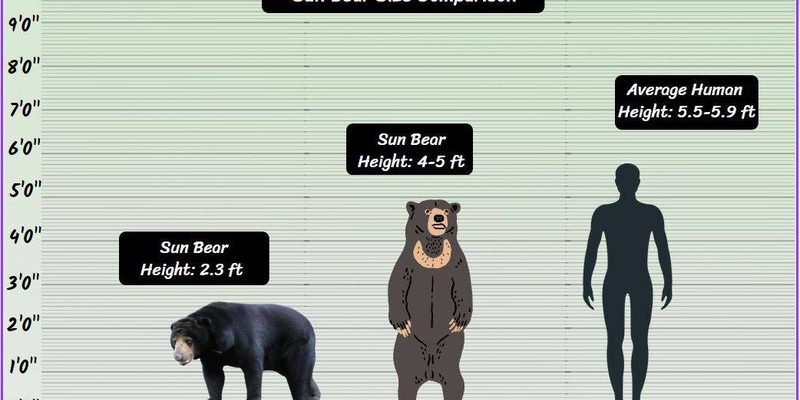![Comparing The Sun Bear Vs. [Similar Species]](https://gudri.com/wp-content/uploads/2025/06/Comparing_The_Sun_Bear_Vs___Similar_Species__image_0.jpg)
Let’s break it down over a cup of coffee. The sun bear, known for its distinctive yellow-orange crescent marking on its chest, is often found in the forests of Southeast Asia. In contrast, the Asian black bear, also known as the moon bear for its white crescent mark, thrives in diverse habitats across Asia, from the Himalayas to forests in Japan. Both bears contribute to their ecosystems, but they do so in very different ways. So, what exactly sets these two bears apart?
Physical Characteristics
When you first glimpse a sun bear, you might not realize how unique it is. These little bears stand about 4 to 5 feet tall when on their hind legs and usually weigh between 60 and 150 pounds. Despite their relatively small size, they have long, curved claws perfect for climbing trees. This makes them agile and gives them access to a variety of food sources like honey and fruits. Their short, sleek fur is usually jet black, making that vibrant chest marking pop.
Now, let’s talk about the Asian black bear. These bears are larger, typically ranging from 4 to 6 feet tall and weighing between 200 and 400 pounds. They have a more robust built and a longer snout compared to sun bears. The Asian black bear’s fur is also black, but it often has a more shaggy appearance. They have a similar crescent marking on their chest, but it tends to be more pronounced. The size difference is significant, but both bears share an impressive climbing ability thanks to their strong limbs.
Habitat and Distribution
The sun bear loves the humid, tropical forests of Southeast Asia, often found in countries like Malaysia, Thailand, and Indonesia. They prefer areas where they can climb trees easily, helping them evade predators and find food. In these lush environments, sun bears play a crucial role in spreading seeds through their foraging. Imagine them as tiny gardeners, helping to maintain the forest’s health.
On the other hand, the Asian black bear occupies a wider range of habitats, from mountainous regions to forests and even temperate zones. They can be spotted in countries like China, India, and even as far east as Japan. This adaptability gives them a slight edge in terms of survival. While sun bears are somewhat confined to tropical areas, Asian black bears can thrive in various environments, which helps them find food and shelter more easily.
Dietary Habits
Both bears are omnivorous, but their diets can differ significantly due to their habitats. Sun bears primarily feed on fruit, honey, and insects. Their long tongues are perfectly designed for reaching into tree bark for honeycombs. It’s pretty fascinating to think about a bear sticking its tongue into a beehive, isn’t it? This sweet tooth not only satisfies their cravings but also helps pollinate plants and disperse seeds.
Asian black bears, however, have a more varied diet that includes fruits, nuts, insects, and even small mammals. They are known to forage through the forest floor, using their strength to uncover hidden food sources. While they will also indulge in honey, they can easily switch to other food options depending on availability. This flexibility in their diet makes them quite resilient in the wild.
Behavior and Social Structure
When it comes to personality, both bears have their own charm. The sun bear is often considered more solitary and can be a bit shy, spending most of its time alone or with a mate during breeding season. They are most active at night, showcasing their unique behaviors under the moonlight. Their solitary nature allows them to wander freely in their territories without interference.
In contrast, Asian black bears can sometimes display more social behavior. While they also enjoy solitude, they might be spotted in small groups, especially during the mating season or when mothers are caring for their cubs. Their adaptability and social tendencies give them an edge when it comes to navigating various challenges in their environment. Imagine a bear making new friends, searching for food together!
Conservation Status
Both the sun bear and the Asian black bear face threats from habitat loss, poaching, and illegal wildlife trade. The sun bear is classified as vulnerable, with numbers dwindling due to deforestation and hunting for their body parts, often used in traditional medicine. Organizations are working hard to create protected areas, but every small action counts in conservation.
The Asian black bear is also classified as vulnerable and faces similar challenges. With its broader distribution, conservation efforts focus on habitat preservation and raising awareness about the impacts of poaching. It’s crucial to support these initiatives and educate others about the importance of these bears in their ecosystems.
So, there you have it! While the sun bear and the Asian black bear share some similarities, their differences are just as striking. The sun bear may be the small, shy friend of the bear world, while the Asian black bear takes the role of the sturdy companion. Understanding these traits allows us to appreciate their unique adaptations and the wonderful roles they play in nature.
As we learn more about these fascinating creatures, we can contribute to their conservation and ensure they continue to thrive in the wild. So next time you hear about sun bears or Asian black bears, remember that each one has its own story, and every step toward conservation matters.

